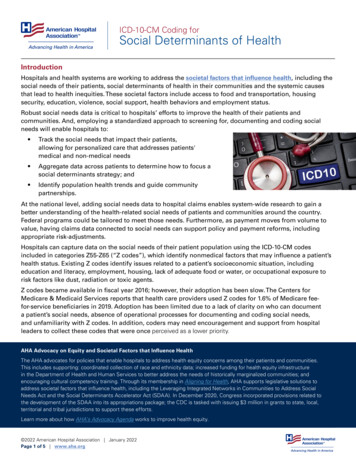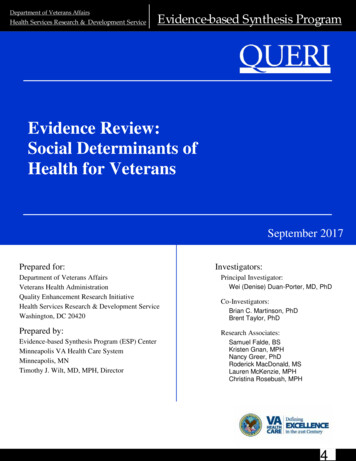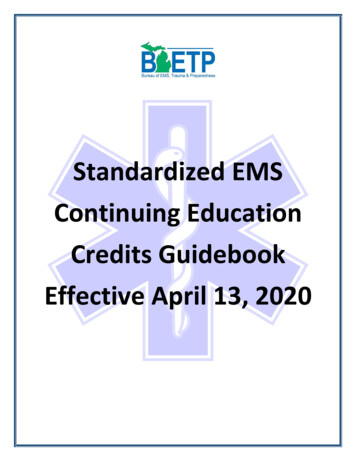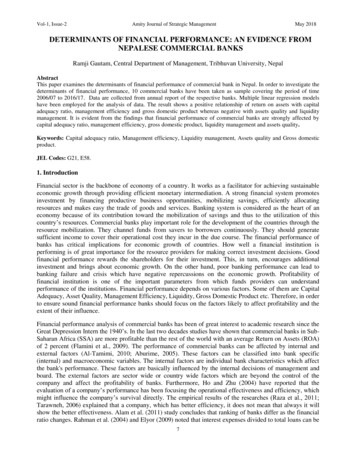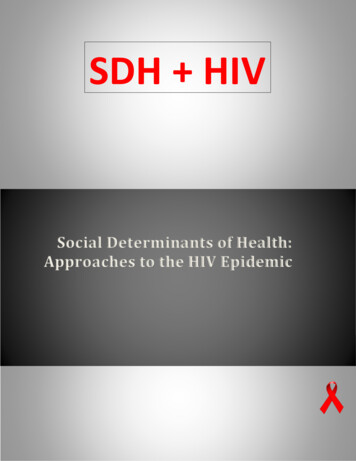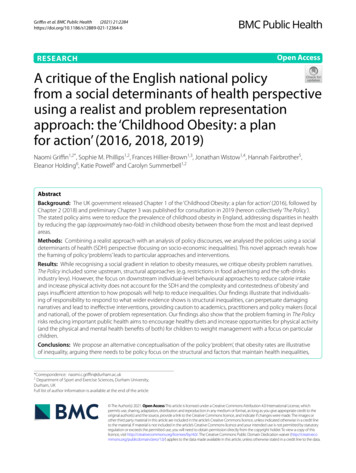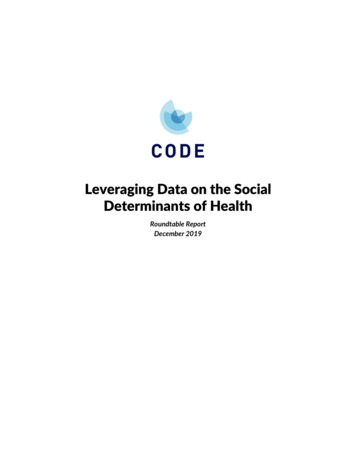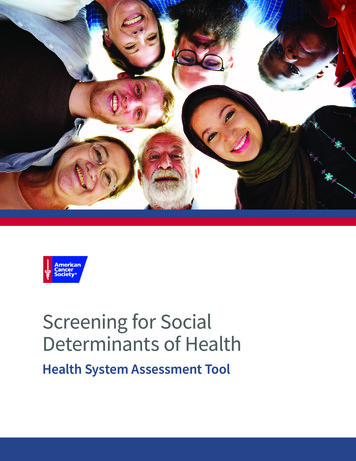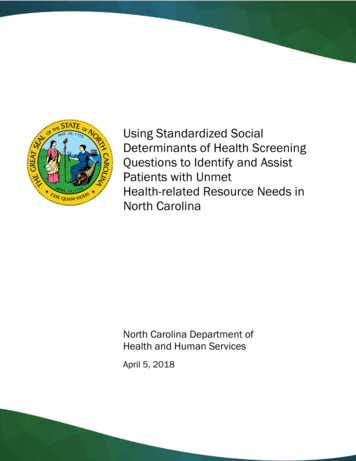
Transcription
Using Standardized SocialDeterminants of Health ScreeningQuestions to Identify and AssistPatients with UnmetHealth-related Resource Needs inNorth CarolinaNorth Carolina Department ofHealth and Human ServicesApril 5, 2018
ContentsI.Introduction. 1II.Rationale for Standardized SDOH Screening Questions . 2III. Development of Standardized SDOH Screening Questions . 2A. Principles .2B. Design Process.3IV. The North Carolina Standardized SDOH Screening Questions . 3A. Food Insecurity .4B. Housing Instability .5C. Transportation.6D. Interpersonal Violence .7E. Optional Domains.8V.Implementation of Standardized Screening Questions within Managed Care . 9VI. North Carolina’s Resource Database and Social Services Integration Platform(NC Resource Platform) . 11Appendix 1: Technical Advisory Group . 13Appendix 2. Optional Secondary Assessment for Housing Needs . 14Appendix 3. Optional Additional Intimate Partner Violence Screens . 15Appendix 4. Possible Questions for Optional Domains . 16Appendix 5. Select Tools, Resources and Links . 21Standardized Social Determinants of Health Screening Questions are an important component of theDepartment of Health and Human Services’ overall SDOH strategy, which may be released separately.The Department welcomes and appreciates input on the Standardized SDOH Screening Questions. Please sendcomments to Medicaid.Transformation@dhhs.nc.gov.For more information about the Medicaid transformation to managed care, visit ncdhhs.gov/medicaidtransformation.
I. IntroductionThe impact of the social determinants of health (SDOH)—including food insecurity, housing instability, unmettransportation needs, and interpersonal violence—on a person’s health and well-being, and health careutilization and cost, is well-established. 1,2 Currently, 90% of health care spending in the United States is onmedical care in a hospital or doctor’s office. Access to medical services is crucial to being healthy. But researchshows that up to 70% of a person’s overall health is driven by these other social and environmental factors,and the behavior influenced by them. 3In North Carolina, people feel the impact of unmet health-related social needs every day. More than 1.2million North Carolinians cannot find affordable housing and one in 28 of our state’s children under age 6 ishomeless. 4,5,6 North Carolina has the 8th highest rate of food insecurity in the United States, with more than 1in 5 children living in food insecure households. In some North Carolina counties, one in three children live infood insecure households. 7 Additionally, nearly one quarter of North Carolina children have experiencedadverse childhood experiences, including physical, sexual or emotional abuse or household dysfunction, likeliving with someone struggling with a substance use disorder. 8 These and other social determinants of healthdisproportionately impact Medicaid beneficiaries, negatively impact health, and drive higher health care costs.We also know that intervening in and addressing beneficiaries’ needs in these areas can have direct impact onthe Medicaid population’s health and can yield a strong short-term and long-term return on health andeconomic outcomes.To meet our mission to improve the health, safety and well-being of all North Carolinians, and to beresponsible stewards of our resources, the North Carolina Department of Health and Human Services (theDepartment) aims to ensure that public dollars are used to buy health—not only health care—for our citizens.In collaboration with partners and stakeholders, the Department envisions establishing North Carolina as anational leader in cost-effectively using its resources, and optimizing the health and well-being of all people, byuniting its communities and health care system to address the full set of factors that impact health.Spurred by North Carolina’s Medicaid transformation to managed care, the Department has begun its workaddressing SDOH through initiatives that include creating standardized screening questions for health-relatedunmet resource needs; a resource database and social service integration platform; a geographic informationsystem “hot spot” mapping of SDOH indicators; and public-private partnership pilots. This paper focuses onthe Department’s work to develop a standardized set of SDOH screening questions. A more comprehensivepaper describing the Department’s overall SDOH strategy may be released separately.B. C. Booske, J. K. Athens, D. A. Kindig et al., Different Perspectives for Assigning Weights to Determinants of Health (University ofWisconsin Population Health Institute, Feb. 2010).2 L. M. Gottlieb, A. Quiñones-Rivera, R. Manchanda et al., “States’ Influences on Medicaid Investments to Address Patients’ SocialNeeds,” American Journal of Preventive Medicine, Jan. 2017 52(1):31–37.3 Schroeder, S. “We can Do Better—Improve the Health of the American People,” The New England Journal of Medicine, Sept. 2007357:1221-1228.4 The National Alliance to End Homelessness. “The State of Homelessness in America.” 2016.5 The U.S. Department of Housing and Urban Development defines an affordable home as one that requires families to spend no morethan 30% of household annual income on housing. Families who pay more than 30% of their income for housing are considered costburdened and may have difficulty affording necessities such as food, clothing, transportation and medical care.6 Administration for Children & Families. “Early Childhood Homelessness in the United States: 50-State Profile.” June 2017.7 NC Child. “North Carolina Child Health Report Card 2018.” 2018.8 Data Resource Center for Child & Adolescent Health. “The National Survey of Children’s Health.” 2012.11
II. Rationale for Standardized SDOH Screening QuestionsSince North Carolina is preparing to transition its Medicaid and NC Health Choice programs from apredominantly fee-for-service delivery system to managed care, there is currently a unique opportunity toengage in system redesign. Over a five-year period, the majority of North Carolina Medicaid beneficiaries willphase into managed care and will enroll in Prepaid Health Plans (PHPs). PHPs will hold responsibility for caremanagement for their enrollees. As set out in the Department’s previous concept paper entitled NorthCarolina’s Care Management Strategy under Managed Care , one of the Department’s guiding principles forcare management is that enrollees will have access to direct linkages to programs and services that addressunmet health-related resource needs affecting social determinants of health (SDOH), along with follow-up andongoing planning. The Department’s inclusion of SDOH as a component of PHP care managementrequirements, therefore, provides an opportunity to consider and standardize how enrollees will be screenedfor unmet health-related resource needs affecting SDOH, as well as how PHPs will be required to address thoseneeds. As detailed below, PHPs will be required to use these screening questions as part of fulfilling theiroverall care management requirements.At the same time as planning is occurring for the transition to managed care, many leading practices andproviders in North Carolina are expressing increasing interest in more systematically addressing SDOH. Whilemost practices are not currently conducting screening on a routine basis, many are beginning to do so and areinterested in a standardized approach. As set out below, the Department is not proposing to require SDOHscreening requirements for providers at this time (whether through the Advanced Medical Home model orotherwise), instead focusing initial operational attention on integration of the SDOH screening questions intothe new PHP care management process flow that will roll out in 2019. However, the Department stronglyencourages practices to carry out SDOH screening, and the Department’s vision is that the new standardizedSDOH screening questions will be shaped by provider input; that they will become familiar to providers; andthat they will eventually become part of routine practice workflows across the state.Standardizing a set of SDOH screening questions will help maintain strong statewide focus on SDOH. Questionsthat have been externally validated and written at an accessible reading level have the potential to improvethe effectiveness of screening, especially in the early and testing phases. Furthermore, having consistentscreening questions and processes will allow for statewide collection of data with respect to the unmet needsof our population and their impact on health outcomes and costs. In turn, this valuable feedback loop willinform policy, planning and investment that can support better ways to address unmet resource needs andimprove the quality of care over time.III. Development of Standardized SDOH Screening QuestionsA. PrinciplesDevelopment of standardized SDOH screening questions has been grounded on the following principles: First, the screening questions need to include domains where high-quality evidence exists linking themto health outcomes, and must identify needs for which there are some resources and services in thecommunity available to address them. Second, the screening questions must be simple, brief and applicable to most populations, so that theycan be easily integrated into workflows in diverse and varied settings across the state. The questionsdo not have to address all nuances of need; rather, a positive response on a screening question should2
trigger a more in-depth assessment that allows a greater understanding of specific needs and moretargeted navigation to resources by a community health worker, care manager, social worker or othermember of the team. Since the questions are intended in time to be used by providers in diversesettings as well as by PHPs, there should be flexibility for PHPs or providers to include additionaldomains as needed or desired by the setting or population being served. Third, the questions must be validated, draw from best practices and must be written at accessiblereading levels to ensure that they can be effectively used. Fourth, to the greatest extent possible, the questions should align with existing screening tools (e.g.Bright Futures Questionnaire, 9 Meaningful Use, Uniform Data Set (Community Health Centers),PRAPARE (Community Health Centers), Accountable Health Community, Pregnancy Medical HomeScreen. This intentional alignment to existing tools will allow for easier implementation and similar datacollection.B. Design ProcessOver the summer of 2017, the Department met with key stakeholders across North Carolina who wereinterested in or already working on initiatives related to SDOH. The Department conducted a literature reviewof best practices related to screening and identifying SDOH, and reviewed existing screening tools. From thisresearch, the Department and stakeholders selected four priority SDOH domains: 1) food insecurity, 2) housinginstability, 3) transportation and 4) interpersonal violence. In addition, the Department compiled a list ofvalidated questions from the various existing tools under each identified domain.In winter 2017-18, the Department convened a Technical Advisory Group (TAG) made up of diverse subjectmatter experts and stakeholders from across the state. 10 The TAG reviewed the design principles and refinedthe list of validated questions. Over four working sessions, the group came to consensus on a recommendedset of standardized SDOH screening questions.IV. The North Carolina Standardized SDOH Screening QuestionsThe standardized SDOH screening questions below are intended to map to the four priority domains specific tounmet health-related resource needs (food security, housing stability, transportation, and interpersonalviolence). The questions are meant to be answered by the individual, or by a parent or caregiver on theindividual’s behalf, and are meant to be short, simple and inclusive so that they can be broadly used.Questions on behavioral health issues (e.g., depression, substance use) and health behaviors (e.g., tobacco,diet, exercise) are expected to be part of routine medical assessment and are therefore not included in thecore set of questions on unmet resource needs above.9Bright Futures. Pediatric Intake Form.List of Technical Advisory Group Members can be found in Appendix 1.103
Contained in Appendices 2, 3 and 4 are additional resources which did not go through the formal TechnicalAdvisory Group (TAG) endorsement process but which could be used by PHPs or providers to add to the coreset of questions, depending on the desire of the agency or setting. Appendix 2 provides an optional secondarytool that assists in better understanding a person’s housing needs and the right resources to address it.Appendix 3 offers optional tools for assessing Intimate Partner Violence. Appendix 4 offers suggestions ofquestions drawn from the other tools referenced in the development of the Department’s standardizedquestions.Standardized SDOH Screening QuestionsThere are programs to help people with needs that can affect their health, but they aren’t reachingeveryone who may need them. Are there things you need help with?Food1. Within the past 12 months, did you worry that your food would run out before you got money tobuy more? (Y/N)2. Within the past 12 months, did the food you bought just not last and you didn’t have money toget more? (Y/N)Housing/Utilities4. Do you have housing? (Y/N)5. Are you worried about losing your housing? (Y/N)6. Within the past 12 months, have you or your family members you live with been unable to getutilities (heat, electricity) when it was really needed? (Y/N)Transportation7. Within the past 12 months, has lack of transportation kept you from medical appointments,getting your medicines, non-medical meetings or appointments, work, or from getting things thatyou need? (Y/N)Interpersonal Safety8. Do you feel physically and emotionally safe where you currently live? (Y/N)9. Within the past 12 months, have you been hit, slapped, kicked or otherwise physically hurt bysomeone? (Y/N)10. Within the past 12 months, have you been humiliated or emotionally abused in other ways byyour partner or ex-partner? (Y/N)Optional to Add11. Are any of your needs urgent? For example, I don’t have food for tonight, I don’t have a place tosleep tonight, I am afraid I will get hurt if I go home today? (Y/N)A. Food InsecurityThe U.S. Department of Agriculture (USDA) defines food insecurity as a lack of consistent access to enoughfood for an active, healthy life. 11 North Carolina has the 8th highest rate of food insecurity overall and the 2ndhighest rate of food insecurity among kids in the United States, with more than 1 in 5 children living in food11United States Department of Agriculture. Definitions of Food Security. 2017.4
insecure households. In some North Carolinacounties, one in three children live in foodinsecure households. 12 Food insecurity hasbeen shown to increase health care costs anddecrease health outcomes among adults. 13 Inaddition, food insecurity in young childrencontributes to developmental delays, impairedschool function, emotional distress and healthrisks through adulthood. 14,15,16,17,18,19Hunger Standardized Questions1. Within the past 12 months, did you worry that yourfood would run out before you got money to buymore? (Y/N)2. Within the past 12 months, did the food you boughtjust not last and you didn’t have money to getmore? (Y/N)Under the food insecurity domain, the SDOH standardized screening questions contain the Hunger Vital Sign—a validated, two-question screening tool that identifies food insecurity or risk of food insecurity. The TAGagreed on this set of questions due to the body of research and evidence demonstrating that this questionidentified people at high risk of food insecurity and, therefore, at risk for being in fair or poor health. Forexample, when compared to children under age 4 who screen as food secure using the Hunger Vital Signsquestions, young children who screen as at risk for food insecurity were 56% more likely to be in fair or poorhealth, 17% more likely to have been hospitalized and 60% more likely to be at risk for developmental delays.When compared to mothers screening as food-secure, mothers screening at risk for food insecurity werealmost twice as likely to be in fair or poor health and almost three times as likely to report depressivesymptoms. 20 The Hunger Vital Sign is already being recommended and used by many stakeholders includingthe American Academy of Pediatrics, 21 the American Academy of Family Physicians, the Accountable HealthCommunities and the USDA U.S. Household Food Security Survey. 22B. Housing InstabilityIn North Carolina, more than 1.2 million people cannot find affordable housing and one in 28 of our state’schildren under age 6, or 26,000 children, 23 is homeless (according to the broader U.S. Department ofEducation definition of homelessness The 2017 “Point in Time Count for NC” found 8,962 persons experiencinghomelessness (according to the U.S. Department of Housing and Urban Development definition ofNC Child. “North Carolina Child Health Report Card 2018.” 2018.Berkowitz SA, et al. BMJ Qual Saf 2016;25:164–172. doi:10.1136/bmjqs-2015-00452114 Cook JT, Black M, Chilton M, et al. Are food insecurity’s health impacts underestimated in the US population? Marginal food securityalso predicts adverse health outcomes in young US children and mothers. Adv Nutr. 2013; 4(1): 51-61.15 Eicher-Miller HA, Mason AC, Weaver CM, McCabe GP, Boushey CJ. Food insecurity is associated with iron deficiency anemia in USadolescents. Am J Clin Nutr. 2009;90(5):1358–1371.16 Skalicky A, Meyers AF, Adams WG, Yang Z, Cook JT, Frank DA. Child food insecurity and iron deficiency anemia in lowincome infantsand toddlers in the United States. Matern Child Health J. 2006;10(2):177–185.17 Rose-Jacobs R, Black MM, Casey PH, et al. Household food insecurity: associations with at-risk infant and toddler development.Pediatrics. 2008; 121(1):65–72.18 Jyoti DF, Frongillo EA, Jones SJ. Food insecurity affects school children’s academic performance, weight gain, and social skills. J Nutr.2005;135(12): 2831–2839.19 Whitaker RC, Phillips SM, Orzol SM. Food insecurity and the risks of depression and anxiety in mothers and behavior problems intheir preschool-aged children. Pediatrics. 2006;118(3).20 Children’s Health Watch. “The Hunger Vital Sign: A New Standard of Care for Preventive Health Policy Action Brief.” 2014.21 Council on Community Pediatrics, Committee on Nutrition. Promoting Food Security for All Children. PEDIATRICS. 2015.22 Coleman-Jensen A, Gregory C, Singh A. 2014. Household Food Security in the United States in 2013. USDAERS Economic ResearchReport Number 173.23 Administration for Children & Families. “Early Childhood Homelessness in the United States: 50-State Profile.” June 2017.12135
homelessness)—of these, 33% were people in families with children and 20% were children 17 and younger. 24There are over 10,000 homeless individuals, including over 1,110 families. In addition, there are over 240,000people living with family, friends or others and at risk of homelessness. 25 Nationally, 1 in 4 families spend morethan 70% of income on rent and utility costs alone.Unstable and unsafe housing for children and families is associated with worse health outcomes, increased useof medical care and increased cost. Children who experience homelessness are more likely to have beenhospitalized since birth. The estimated total annual cost of hospitalizations attributable to homelessnessamong children ages 4 and under in 2015 were over 238 million nationally. 26 Housing problems have beenassociated with a wide array of health conditions, including lead exposure, asthma and depression. 27 Thoseexperiencing homelessness are more likely to haveHousing/Utilities Standardized Questionsmultiple comorbidities and be high-users of healthcare and the emergency room. Housing stability can1. Do you have housing? (Y/N)2. Are you worried about losing your housing? (Y/N)decrease health care costs and improve health.3. Within the past 12 months, have you or your familyHousing with utility needs is also linked with poormembers you live with been unable to get utilities(heat, electricity) when it was really needed? (Y/N)health outcomes. In North Carolina, more than10,500 households go without heat in the winter.And more than 16,500 homes do not have indoor plumbing. 28 Babies and toddlers who live in energy insecurehouseholds are more likely to be in poor health, to have a history of hospitalizations, and to be at risk fordevelopmental problems. 29 In addition, energy insecurity does not usually occur in isolation—families whoreceived energy assistance through LIHEAP (Low Income Home Energy Assistance Program), for example, were14% more likely to be housing secure than families not receiving energy assistance. 30The SDOH standardized screening questions contain three questions related to housing instability. All threequestions are drawn from PRAPARE, a nationally validated assessment tool. 31 Some stakeholders asked foradditional screening questions for those who screened positive on one or more of these questions. Appendix 2provides an optional secondary tool that assists users in better understanding a person’s housing needs andthe right resources to address them. This secondary tool was not subject to the formal TAG endorsementprocess, but parallels assessment categories in the Homeless Management Information System (HMIS).C. TransportationLimited access to transportation is often cited aslimiting access to health care as transportationbarriers lead to missed appointments and delayedcare, which, in turn, often lead to poorermanagement of chronic disease and worse healthTransportation Standardized QuestionWithin the past 12 months, has lack of transportationkept you from medical appointments, getting yourmedicines, non-medical meetings or appointments,work, or from getting things that you need? (Y/N)North Carolina Coalition to End Homelessness. “North Carolina Point-in-Time Count Data.” 2017.The National Alliance to End Homelessness. “The State of Homelessness in America.” 2016.26 Sandel L and Desmond, M. Investing in Housing for Health Improves Both Mission and Margin. JAMA. 2017.27 Shaw M. Housing and public health. Annu Rev Public Health. 2004;25:397-418.28 The Duke Endowment. “Expanding Affordable Rural Housing.”29 Cook JT, Frank DA, Ettinger de Cuba S et al. Energy Insecurity is Positively Associated with Food Insecurity and Adverse HealthOutcomes in Infants and Toddlers.30 Children’s Health Watch. “Energy Insecurity is a Major Threat to Child Health, Policy Action Brief.” 2010.31 PRAPARE: Protocol for Responding to and Assessing Patients’ Assets, Risks and Experiences PARE Paper Form Sept 2016.pdf Sep 02, 201624256
outcomes. In 25 separate studies, 10–51% of patients reported that transportation was a barrier to health careaccess. 32Transportation barriers also limit a person’s ability to access healthy food and community supports. In NorthCarolina, more than 1.85 million residents—almost 20% of the total state population—have low access to agrocery store. That number includes almost half a million children and about a quarter of a million seniors.Additionally, out of the total number of North Carolinians with low access to a store, 622,400 are low-income;and more than 100,000 North Carolina residents have low access to a store and no household vehicle, makingit extremely difficult for them to purchase food on a regular basis. 33 Older adults and individuals withdisabilities who live in their community and do not have access to transportation report higher rates of socialisolation. Research shows that socially isolated adults undergo early admission to residential or nursing care,and have an increased use of emergency rooms and physician visits. In addition, social isolated adults haveincreased risk for depression. 34The North Carolina SDOH standardized screening questions contain one question related to transportationthat was drawn from the PRAPARE tool.D. Interpersonal Violence“Interpersonal violence” refers to violence between individuals and is subdivided into family and intimatepartner violence, and community violence. 35 Nationally, nearly 1 in 6 pregnant women in the United States hasbeen abused by a partner. Almost 44% of North Carolina women experienced intimate partner violence in theirlifetime—almost 25% more than the nationalaverage, ranking North Carolina 47th. 36Interpersonal Violence Standardized QuestionsAdditionally, North Carolina ranks 30th in the1. Do you feel physically and emotionally safe whereUnited States in the prevalence of Adverseyou currently live? (Y/N)Childhood Experiences (ACEs), which include2. Within the past 12 months, have you been hit,physical, sexual or emotional abuse or householdslapped, kicked or otherwise physically hurt bydysfunction like living with someone strugglingsomeone? (Y/N)with a substance use disorder. In North Carolina,3. Within the past 12 months, have you been24.3% of kids have experienced two or more ACEshumiliated or emotionally abused in other ways byand 21.9% of adults have experienced three or37your partner or ex-partner? (Y/N)more ACEs.Violence against women is linked to many long-term health problems, including arthritis, asthma, chronic pain,digestive problems (e.g., stomach ulcers), heart problems, irritable bowel syndrome, problems sleeping,migraine headaches, stress and problems with the immune system. Many women also have mental health32 Syed S, Gerber B and Sharp L. “Traveling Towards Disease: Transportation Barriers to Health Care Access,” J Community Health, Oct.2013; 38(5): 976–993.33 Morgan M, Downer S and Lopinsky T. “The Diabetes Epidemic in North Carolina: Policies for Moving Forward.” 2014 North CarolinaState Report (The Center for Health Law and Policy Innovation of Harvard Law School). 2014.34 Valtorta N and Hanratty B. “Lonliness, isolation and the health of older adults: do we need a new research agenda?” JRSM, Dec.2012; 105(12): 518-522.35 World Health Organization. “Definition and typology of violence.”36 2016 Health of Women and Children’s Report, America’s Health Rankings. “Intimate Partner Violence-Lifetime.” 2016.37 Data Resource Center for Child & Adolescent Health. “The National Survey of Children’s Health.” 2012.7
problems after violence. 38 Women who experience intimate partner violence before and during pregnancy areat an increased risk of low maternal weight gains, infections and high blood pressure, and are more likely todeliver pre-term or low birth weight babies. Screening for intimate partner violence is recommended by the USPreventive Services Task Force.39The SDOH standardized screening questions contain three questions related to interpersonal safety. The firstquestion is an overall general interpersonal safety question drawn from PRAPARE that may reflect family andintimate partner or community violence. The second question reflects interpersonal physical violence and wasdrawn from the Community Care of North Carolina (CCNC) Pregnancy Medical Home Pregnancy Risk ScreeningForm that has been used in North Carolina since 2011 and has been shown to be a strong predictor of healthrisk. 39 This question is also used or recommended by the American College of Obstetricians and Gynecologists,public health Title X funded clinics, and the Health Begins screening tool. The third question was drawn fromthe Humiliation, Afraid, Rape, Kick (HARK) tool and screens for the emotional abuse aspect of intimate partnerviolence.For some settings, especially OB/GYN or women’s health settings, full screens for intimate partner violence isrecommended. Appendix 3 provides two full screens that could be used in those settings, if desired. Thesecondary screens did not go through the formal endorsement process of the TAG, but align with other NorthCarolina initiatives. The first tool given in Appendix 3 is the full set of Pregnancy Medical Home questionscurrently being used in the North Carolina Pregnancy Medical Home program. The second tool is theHumiliation, Afraid, Rape, Kick (HARK) tool that aligns with screening initiatives by the North Carolina CoalitionAgainst Domestic Violence.These three questions around interpersonal safety are not meant to be a proxy or replacement for a full ACEscreening. Performing a full ACE screening allows for th
Standardized Social Determinants of Health Screening Q uestions are an important component of the Department of Health and Human Services' overall SDOH strategy, which may be released separately.
